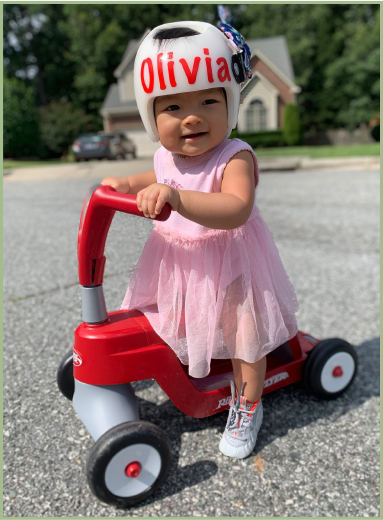

Babies with an asymmetric head shape (typically, a flattening in one spot) have positional plagiocephaly caused by pressure on the bones of the skull before or after birth. Whether the flattening is obvious or barely noticeable, cranial helmets have a high success rate for reshaping an infant’s skull.
Also called “positional flat head syndrome,” plagiocephaly is diagnosed during a physical exam with a pediatrician or craniofacial specialist who assesses the head shape and facial asymmetry and takes a detailed history of the baby’s positioning habits, birth story, and developmental milestones. In some situations, imaging such as x-rays or CT scans are taken to rule out more serious conditions like craniosynostosis. The pediatrician or specialist may then issue a referral for an evaluation with a pediatric-certified and licensed orthotist at Human Technology Prosthetics and Orthotics.
Fortunately, treatment for plagiocephaly is usually non-invasive. Repositioning and physical therapy are effective treatments while the skull and brain are still growing, which mostly concludes by the age of two.
In minor cases, head shape can improve on its own. For mild to moderate plagiocephaly, “aggressive repositioning” refers to the more intensive or structured approach to repositioning a baby to help correct the shape of the skull. Key components are 1) alternating head positions during sleep to avoid prolonged pressure on one area of the skull and promote natural rounding, and 2) frequent tummy time to promote neck muscle development, increase head control, and relieve pressure.
Helmet therapy is an effective option for more severe cases. Surgery is almost never required.


A cranial remolding helmet is a custom-fitted orthotic device designed to gently reshape an infant’s skull. It is primarily used to treat positional plagiocephaly (a condition where one side of a baby’s head is flattened), but it can also be used to treat brachycephaly (flattening of the back of the head) and scaphocephaly (elongation of the skull).
The goal of cranial helmets is to guide the skull’s growth in a way that encourages a more symmetrical shape while preventing further flattening or abnormal growth. The helmet gently exerts pressure on the more prominent areas of the skull and allows more space for growth in the areas that need it. The helmet is most effective during the first 6-12 months of life when the skull is still soft and flexible.
The skilled team at Human Technology is pleased to help infants and their families with the best quality orthoses. Our cranial helmets are lightweight, breathable, custom-fit, and adjustable. The infant’s health and comfort are our priorities. Human Tech supplies a full line of cranial remolding helmets, including the STAR family from Orthomerica Inc.
An evaluation for a cranial remolding orthosis requires a prescription. Then a Human Technology practitioner will take measurements and perform a scan to corroborate the diagnosis, with the information provided to the insurance company to determine coverage for the cranial remolding helmet orthosis.
Practically all our patients receive approval from their health insurance plan within 2-4 weeks of the evaluation appointment. Our staff works with parents to process the claim, supplying the required clinical conditions to obtain coverage. Infrequently, a health plan does not cover the helmet, and parents are instructed to contact their policy provider with a request for the orthosis under the device code S1040.

The scanning process for cranial helmets is a key part of creating a custom-fit device for reshaping the baby’s skull. The scanners we use are safe for infants, and no eyewear or protection is needed. The scan itself is quick and precise, capturing the details of the head shape including flat spots, asymmetry, and any other deformities. The highly accurate data is collected and downloaded to a five-axis carver for making the orthosis.
The FDA requires cranial remolding orthoses to be fit within 14 days of the scan date. Exceeding this period may lead to an ill-fitting orthosis, which may necessitate a new scan.
To ensure the helmet’s fit and performance, a follow-up visit is scheduled four weeks after use begins. Additional visits are usually every 4-6 weeks thereafter, depending on the infant’s age and the situation’s seriousness.
Early intervention and regular follow-up are important for monitoring progress and achieving successful outcomes. Contact Human Technology today to schedule your appointment. Our skilled team is dedicated to serving infants and their families, offering the best experience possible through the use of the most suitable orthotics for the situation.